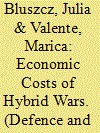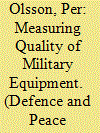|
|
|
Sort Order |
|
|
|
Items / Page
|
|
|
|
|
|
|
| Srl | Item |
| 1 |
ID:
188409


|
|
|
|
|
| Summary/Abstract |
With more than ten thousand casualties, the ongoing hybrid Ukrainian war between pro-Russian separatists and the government in the Donbass region, Ukraine’s productive core, has taken a severe toll on the country. Using cross-country panel data over the period 1995–2017, this paper estimates the causal effects of the Donbass war on Ukraine’s GDP. Our counterfactual estimation by the synthetic control method shows that Ukraine’s per capita GDP foregone due to the war amounts to 15.1% on average for 2013–2017. Separate analysis for the affected regions of Donetsk and Luhansk indicates an average causal effect of 47% for 2013–2016. Results are robust to pre-war confounds, namely, the Orange Revolution and Ukrainian-Russian gas disputes. As such, we discuss mechanisms underlying the war’s causal effects on economic performance, which is of broader relevance for debates on the role of government in hybrid conflict management.
|
|
|
|
|
|
|
|
|
|
|
|
|
|
|
|
| 2 |
ID:
188410


|
|
|
|
|
| Summary/Abstract |
For decades, the concept of deterrence and the fear for nuclear confrontation withheld large powers from waging aggression against each other. Recent technological developments and the growing interconnectedness however allowed some states to find ways to challenge the West by using so called ‘hybrid threats’. This way of waging war entails the synchronized use of a broad spectrum of instruments that are well-designed to stay below the thresholds of detection, attribution and retaliation. Combining these (relatively cheap) threats with conventional military hard power confronts the liberal democracies with a difficult choice in terms of defence budget allocation. Whereas arms race stability in the conventional and nuclear domain leads to a peaceful stalemate, this article demonstrates that adding hybrid threats to the spectrum of state power projection leads to a gradual shift of the power balance. While hybrid threats have been extensively studied within the international relations literature, we are (to the best of our knowledge) the first to study these changing security paradigms from a defence economic point of view. Moreover, this article is the first to represent this increasingly complicated state power competition in a game theoretic framework.
|
|
|
|
|
|
|
|
|
|
|
|
|
|
|
|
| 3 |
ID:
188411


|
|
|
|
|
| Summary/Abstract |
This study evaluates the possibility of having a causal link between geopolitical risk (GPR) and defence expenditure (DE) by employing panel bootstrap Granger causality method. The results highlight the causality running from GPR to DE in China, India, and Saudi Arabia. In other words, the GPR in the form of border disputes, wars and terrorism threats can pursuade countries to increase their defence expenditure. The results we obtain for these three countries are also supported by the neoclassical model, which asserts that GPR is a significant contributor to DE. Contrary to above, there are evidences for reverse causality as well where DE is causing GPR in South Korea and Turkey. The most probable reasons for reverse causality could be the various alliances for regional security by the countries and their dependency on the import of military equipment. The results indicate an insignificant relationship between GPR and DE in Brazil, Israel, and Russia; where the DE is mainly determined by the internal political system and its contribution towards employment generation. On the basis of our results, it can be inferred that the convergence of regional interests in the form of a peaceful solution of disputes may guarantee security. Also, the formulation of the policies that are independent and isolated from the influence of external powers, can help in controlling the ever-increasing DE and GPR in these countries.
|
|
|
|
|
|
|
|
|
|
|
|
|
|
|
|
| 4 |
ID:
188415


|
|
|
|
|
| Summary/Abstract |
This paper introduces the Missile Tests Dataset which consists of the publicized and undisclosed missile tests conducted by 15 countries that initiated their missile development programs sometime between 1946 and 2015. Then it statistically explores factors that affect how frequently these countries test-launch their missiles. In that regard, three broad possibilities are investigated: (i) increases in missile tests following decisions to upgrade the missile arsenal or missile-dependent technologies, (ii) increases in missile tests as a retaliation to foreign military threats, and (iii) decreases in missile tests due to economic costs introduced by sanctions. Negative Binomial regression analyses suggest that decisions to upgrade missile and missile-dependent technologies increase all missile tests but have no consistent effect on publicized missile tests. Threats of military nature have surprisingly no consistent effect on all or publicized missile tests. However, receiving economic sanctions increase publicized missile tests. The paper concludes with a discussion of future research possibilities, and policy recommendations.
|
|
|
|
|
|
|
|
|
|
|
|
|
|
|
|
| 5 |
ID:
188414


|
|
|
|
|
| Summary/Abstract |
This article aims to present and discuss a method for estimating military equipment quality, while also comparing this approach to previous methods developed with the same purpose. Using main battle tanks as an example, the suggested method’s structure and preliminary results are presented while its potential merits and limitations are also discussed. Preliminary results of the method show that US and western European tanks have traditionally had an qualitative edge. However, they also suggest that modern Russian and Chinese tanks have narrowed this gap. Equipment performance models, such as the one presented in this article, could provide additional insights when assessing the global and regional power balances as well as when estimating purchasing power parities and equipment cost escalation. This article will hopefully encourage further discussion on how to measure and compare military equipment quality.
|
|
|
|
|
|
|
|
|
|
|
|
|
|
|
|
| 6 |
ID:
188412


|
|
|
|
|
| Summary/Abstract |
This paper aims to contribute to the theoretical discussions on the effect of military spending on the economy. To this end, it first modifies the circuit of capital model proposed by Duncan Foley in 1982, which represents money value stock-flow relations for capital in Capital Volume II. Foley’s model is extremely useful for examining the relationship between military spending and the rates of profit as it allows one to specify the parameters in both the military and civilian sectors. By incorporating the military sector, the adapted model shows that a larger military sector is associated with a higher rate of profit. Second, the paper provides some empirical evidence on the US for 1968–2008 for the main proposition of the theoretical model.
|
|
|
|
|
|
|
|
|
|
|
|
|
|
|
|
| 7 |
ID:
188413


|
|
|
|
|
| Summary/Abstract |
This study explores the impact of random changes in risk perceptions that occur as a result of terrorist attacks by examining abnormal variations in defence sector valuations. Using a market model event study methodology, the market impacts of three different sets of terror events are measured: Mass casualty events, events that occur in OECD countries, and events that occur in BRICS countries. The findings are tested against a series of explanatory variables that capture characteristics of the domestic defence sector for 21 country-level sector indices and characteristics of the event itself. Results demonstrate that the response of the defence sector to terror events depends more on event characteristics than economic characteristics, contrary to much of the prevalent literature. We also find that speculation in the defence sector persists for several days following an attack indicating that investors broadly expect a military response, particularly in the case of mass casualty events.
|
|
|
|
|
|
|
|
|
|
|
|
|
|
|
|
|
|
|
|
|